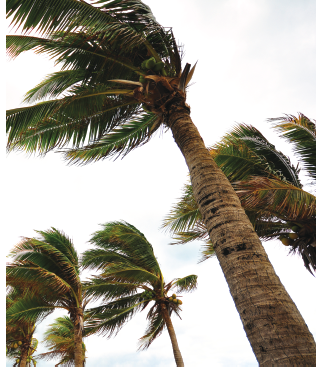As Galveston Island braces for the peak of hurricane season, gardeners face the daunting task of safeguarding their green spaces against nature's wrath.
The Atlantic hurricane season, which spans from June 1 to November 30, reaches its most volatile period in September. This month has historically seen more Category 5 hurricanes than any other, with 21 storms achieving this highest intensity.
Notable among these is the infamous hurricane of September 8, 1900, which decimated Galveston, claiming over 8,000 lives and destroying more than 2,600 homes. This tragic event remains the deadliest natural disaster in U.S. history.
In recent years, September has continued to live up to its reputation. In 2019, Hurricane Dorian, a Category 5 storm, wreaked havoc in the Bahamas with wind speeds of 185 mph before affecting the southeastern U.S.
Similarly, 2017 saw the devastation of Hurricanes Irma and Maria, both Category 5 storms, which tore through the Caribbean, leaving lasting impacts on Puerto Rico and the Florida Keys.
Given the severity of these storms, preparation and post-storm cleanup are crucial for gardeners on Galveston Island.
“The most important consideration here is your safety,” James Boone Holladay, M.Ed., a County Extension Agent II at Texas A&M AgriLife Extension - Galveston said.
“Before entering areas impacted by storms, inspect for damaged structures, trees, and utility infrastructure. Also, Texas Parks & Wildlife recently put out a notice to watch for dangerous wildlife, particularly snakes, as the storm may have displaced many," Holladay said.
 When it comes to the garden, Holladay recommends you don’t rush to remove or prune damaged plants.
When it comes to the garden, Holladay recommends you don’t rush to remove or prune damaged plants.
"If [your] trees and plants are not posing any safety hazard, you might want to hold off before making any decisions you may regret in time. Trees and shrubs may look rough but, with proper management, may be saved," he said.
“Applying compost to stressed plants and reapplying mulch to garden beds are key steps in helping the landscape recover. The extra organic matter, teaming with beneficial microorganisms, helps to slowly feed plants with severe stress symptoms. Just spread it over beds and turf areas and then water.”
“Second, reapplication of wood mulch in landscape beds is a good idea because previous layers may have washed away,” Holladay continued.
In terms of flood mitigation around the yard, Holladay suggests incorporating features like dry rock furrows, swales, rain gardens, and French drains to help manage heavy water flow.
"As gardeners along the Gulf Coast [we are] either conserving water or getting rid of it.”
As September continues to unfold, bringing with it the peak of hurricane season, Galveston gardeners need to stay safe and take the necessary steps to help their gardens recover.
“The main thing here, to repeat over and over, is not to overreact. Your plants are [already] stressed by the wind and flooding impacts. They have also lost much of their leaves," he said.
“Further, we are in the hottest part of summer. So, don't stress your plants more than they already are."
With patience and the right techniques, gardeners can help their landscapes endure and recover from the challenges of hurricane season.
Hurricane Preparation for Gardens
Galveston Monthly has put together this list of suggestions to help prepare your garden and landscape for peak hurricane season.
Prune Trees and Shrubs: It’s important to think ahead when preparing your trees for the hurricane season.
Prune to remove dead or damaged branches and for minor shaping any time of year. Regularly trimming back overgrown branches and foliage helps reduce wind resistance. During peak hurricane season, remove any dead or weak branches that could break off during a storm.
Secure Loose Items: Move outdoor furniture, garden tools, and other loose items indoors or to a sheltered area. This prevents them from becoming dangerous projectiles in high winds.
Check Drainage Systems: Ensure that gutters, downspouts, and storm drains are clear of debris to prevent flooding. Proper drainage helps manage excess water during heavy rains.
Stake Young Trees: Secure young or newly planted trees with additional stakes to help them withstand strong winds. This supports their roots and prevents them from toppling over.
Protect Delicate Plants: Move smaller or delicate plants indoors or to a garage before a storm. This helps shield them from wind and rain damage.
Anchor Heavy Objects: Secure heavy items like mailboxes, fences, and large planters to the ground to prevent them from being uprooted or blown away.
Prepare Rain Barrels: If you use rain barrels, make sure they are securely fastened or moved to a safe location to prevent them from being damaged or displaced.
Remove Potential Hazards: Clear away any debris, such as fallen branches or loose rocks, that could become hazardous during a storm.
Plan for Water Management: Consider installing pavers or other erosion control measures in areas prone to runoff to prevent soil erosion during heavy rains.
Choose Wind-Resistant Plants: Plant species that are known for their wind resistance, such as sabal palms, live oaks, and crape myrtles. These plants are more likely to withstand strong winds.
Turn off Your Irrigation Systems: This last suggestion is just for when a strong storm system is nearing your home. A day or two before the big storm or hurricane is forecasted to hit, you should turn off your irrigation systems. This is especially true if your yard and neighborhood have a lot of trees. If a tree comes down and breaks the water line, the water can add to flood problems.
These steps can help protect your garden and landscape from the impacts of hurricanes, ensuring they remain resilient and beautiful even during stormy weather.